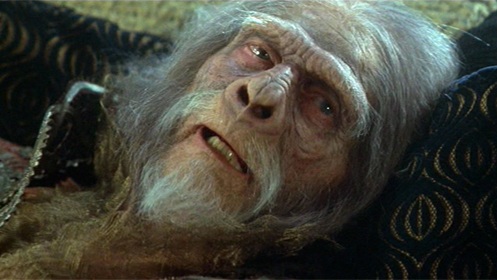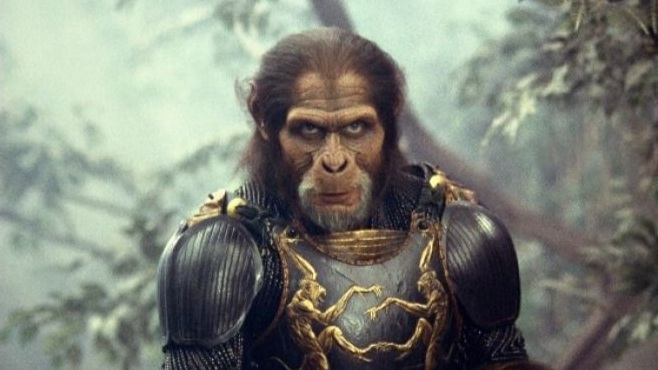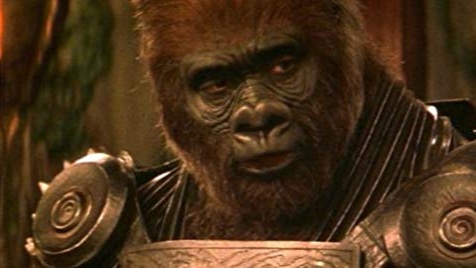PLANET OF THE APES (2001) Ending Explained, & I Think It Works
By Jon Therkildsen
The problem with PLANET OF THE APES (2001) is that it seems to mix the 1963 book and the 1968 movie endings oddly together. Which only bewilders. And the ending then seems senseless.
It ends with our hero leaving the foreign planet along with a newly established peace between humans and apes. When he lands back on Earth, all of Earth is run by Apes. But it is our world, recently taken over. The Lincoln Statue has been updated to praise Bad Guy Thade instead.
How is that possible?
How did bad-guy-Thade get to Earth? How did Thade take over Earth? How could he do it so fast, as we seem to be in our time?
Total confusion. End credits.
I have read explanations including Thade fixing the old stranded spaceship somehow magically, etc. But I feel those explanations come short and merely try to patch an already sunken boat.
But I think I have a solution that works.
The main problems, in the end, are the following:
How could a fairly current Earth that he travels back to be taken over by Apes?
How could Thade have been this "liberator" on Earth, as he was last seen defeated in a destroyed old spaceship back on that other planet, in the future?
What if,
the planet, in the beginning, was always Earth - just millennia into the future.
What if,
"Thade" is a generic name given to those in charge - not unlike, how Caesar is an imperial title passed on in our own history.
What if,
everything we see happen in the movie is in the far future of Earth. Just like the first movie from 1968.
What if,
when Davidsson travels back to Earth, and back in time, he actually travels to a point in time where the Ape revolution already had resulted in the Apes taking over Earth? Just like in the book from 1964.
These "what if's" explain why we see a Lincoln statue of a Thade. It is not our Thade, it is the original Ape Caesar, who was named Thade. And because of his success, all future rulers would so be named Thade (like our Tim Roth, thousands of years later).
These "what if's" explain why we see human landmarks and general society intact in the end. It is because Davidson arrives in a time where the takeover had recently happened... and so still quite fresh.
These "what if's" also explain why we have de-evolved humans and Apes in the future through most of the movie. The first "planet" he lands on is the Earth gone bad AGAIN, causing Apes to be living in a more primitive post-apocalyptic world.
The moral is, I suppose, neither humans nor apes guarantee prosperity.
In other words ;
Apes will inherit the Earth.
Davidson crashes in the far future, where the Earth is primitive but still run by Apes - and have been for many many years.
His actions there help unite Ape and Man - which, perhaps, for the first time ever will lead to a hopeful future for all.
Davidson lands back in the past, still ahead of his own original time, but when Apes had somewhat recently inherited (taken over) our Earth.
A Thade was the first Ape to lead and liberate its kind, and so this name was sickled in the Lincoln-Ape statue.
The bad guy in this movie is Tim Roth's Thade, and he did not win. He ended his life possibly as a prisoner in the far future where man and Ape finally learned to coexist and hopefully would build a sustainable future together for the first time ever.
One problem: The first planet has several moons.
One explanation: This is the far future, where even Ape society has fallen and become a mere shadow of its former glory. In this time period, astral events could have caught other rocks around Earth's gravity making another moon. Or perhaps the Apes destroyed the moon (split in two) in some crazy space race, and in doing this dooming their then advanced society. Which incidentally also explains why they (when we enter the story) are relatively primitive. It is after an ape-apocalypse.
What do you think?
I like my idea as it sort of combines the original movie with the book. The first planet is a far-future Earth (the 1968 movie) and the second planet is Earth when it has been taken over by Apes (the 1963 book). Each is quite different, and it would seem Tim Burton tried to reconcile the two narratives?
My interpretation above shows that perhaps he succeeded?
Photos via Google - © 2001 THE ZANUCK COMPANY





